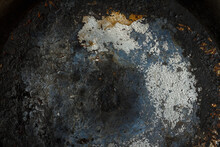How To Clean A Cast Iron Skillet With Burnt-On
Cast iron skillets are beloved by many home cooks for their durability and ability to retain heat. However, one common challenge that cast iron skillet owners face is dealing with burnt-on food. Whether it’s a result of a cooking mishap or simply the residue of repeated use, removing burnt-on food can seem like a daunting task. In this article, we will explore effective methods and techniques to clean a cast iron skillet with burnt-on food, ensuring that your skillet remains in top condition for years to come.
Why Cleaning a Cast Iron Skillet Properly is Important
Before diving into the cleaning methods, it’s essential to understand why cleaning a cast iron skillet properly is crucial. Cast iron skillets require special care to maintain their seasoning, which is a layer of polymerized oil that provides a non-stick surface and prevents rusting. Improper cleaning techniques can strip away this seasoning, leaving the skillet vulnerable to rust and food sticking to its surface.
Additionally, burnt-on food can affect the flavor of future dishes cooked in the skillet. The remnants of burnt food can impart an unpleasant taste to your meals, compromising the quality of your cooking. By cleaning your cast iron skillet properly, you can ensure that it remains in optimal condition and continues to enhance your culinary creations.
Method 1: Scrubbing with Salt and Oil
One effective method to remove burnt-on food from a cast iron skillet is by scrubbing it with salt and oil. Here’s how:
- Allow the skillet to cool down completely before cleaning.
- Sprinkle a generous amount of coarse salt onto the surface of the skillet.
- Using a paper towel or a clean cloth, scrub the salt into the burnt-on food, applying gentle pressure.
- Once the majority of the burnt-on food has been loosened, rinse the skillet with warm water.
- Next, pour a small amount of oil onto the skillet and use a paper towel to spread it evenly across the surface.
- Place the skillet on the stovetop over low heat for a few minutes to allow the oil to penetrate and protect the skillet.
- Finally, wipe off any excess oil with a paper towel and store the skillet in a dry place.
This method is effective for removing burnt-on food while preserving the skillet’s seasoning. The salt acts as an abrasive, while the oil helps to re-season the skillet, preventing rust and maintaining its non-stick properties.
Method 2: Boiling Water and Baking Soda
Another method to tackle burnt-on food is by using boiling water and baking soda. Follow these steps:
- Fill the cast iron skillet with water, covering the burnt-on food.
- Place the skillet on the stovetop and bring the water to a boil.
- Add a tablespoon of baking soda to the boiling water.
- Allow the mixture to simmer for about 10 minutes.
- Turn off the heat and carefully discard the water.
- Using a sponge or a brush, scrub away any remaining burnt-on food.
- Rinse the skillet with warm water and dry it thoroughly.
This method utilizes the power of boiling water and baking soda to loosen and remove burnt-on food. Baking soda is a gentle abrasive that helps to lift the residue, making it easier to scrub away.
Method 3: Vinegar Soak
Vinegar is a versatile household ingredient that can also be used to clean a cast iron skillet with burnt-on food. Here’s how:
- Mix equal parts of water and white vinegar in a container large enough to submerge the skillet.
- Place the skillet in the vinegar solution and let it soak for a few hours or overnight.
- After soaking, remove the skillet and scrub away the burnt-on food using a sponge or brush.
- Rinse the skillet thoroughly with warm water.
- Dry the skillet completely to prevent rusting.
Vinegar’s acidity helps to break down the burnt-on food, making it easier to remove. However, it’s important to note that prolonged exposure to vinegar can strip away the skillet’s seasoning, so it’s crucial to rinse and dry the skillet thoroughly after cleaning.
FAQs
1. Can I use soap to clean a cast iron skillet with burnt-on food?
Using soap to clean a cast iron skillet is generally discouraged as it can strip away the seasoning. However, if the burnt-on food is particularly stubborn, a small amount of mild dish soap can be used. Just make sure to rinse the skillet thoroughly and re-season it afterward.
2. Can I use steel wool or abrasive scrubbers?
While steel wool or abrasive scrubbers can be effective in removing burnt-on food, they can also damage the skillet’s seasoning. It’s best to avoid using them unless absolutely necessary. Instead, opt for gentler scrubbing tools like a sponge or brush.
3. How often should I clean my cast iron skillet?
It’s recommended to clean your cast iron skillet after each use to prevent the buildup of burnt-on food. Regular cleaning helps to maintain the skillet’s seasoning and ensures optimal cooking performance.
4. Can I use an oven cleaner on a cast iron skillet?
No, oven cleaners are too harsh for cast iron skillets and can damage the seasoning. Stick to the methods mentioned in this article for safe and effective cleaning.
5. How do I re-season my cast iron skillet?
To re-season a cast iron skillet, apply a thin layer of oil to the entire surface, including the handle. Place the skillet upside down in an oven preheated to 375°F (190°C) and bake for one hour. Allow the skillet to cool completely before using or storing.
6. What if my cast iron skillet is rusted?
If your cast iron skillet has developed rust, you can remove it by scrubbing with steel wool or a scrub brush and a mixture of equal parts water and white vinegar. After removing the rust, rinse the skillet thoroughly, dry it completely, and re-season it.
Summary
Cleaning a cast iron skillet with burnt-on food doesn’t have to be a daunting task. By following the methods outlined in this article, you can effectively remove burnt-on food while preserving the skillet’s seasoning. Remember to allow the skillet to cool before cleaning




